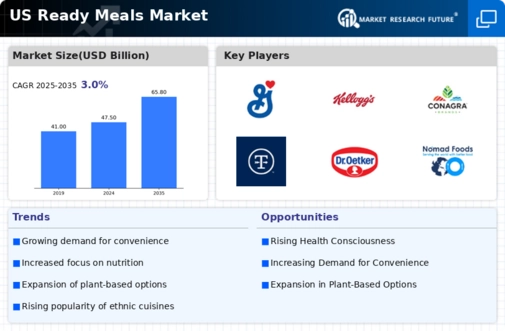Market Growth Projections
The Global US Ready Meals Market Industry is poised for substantial growth, with projections indicating a market size of 235.94 USD Billion in 2024 and an anticipated increase to 541.32 USD Billion by 2035. This growth trajectory suggests a robust compound annual growth rate (CAGR) of 7.84% from 2025 to 2035. Such figures highlight the increasing consumer reliance on ready meals as a convenient dining option. The market's expansion is likely to be fueled by various factors, including evolving consumer lifestyles, health trends, and technological advancements in food production.
Rising Demand for Convenience Foods
The Global US Ready Meals Market Industry experiences a notable increase in demand for convenience foods. As lifestyles become increasingly hectic, consumers are seeking quick meal solutions that do not compromise on taste or nutrition. This trend is reflected in the projected market size, which is expected to reach 235.94 USD Billion in 2024. The growing number of dual-income households and the rise in single-person households further contribute to this demand, as individuals prioritize convenience over traditional cooking methods. Consequently, manufacturers are innovating to create ready meals that cater to diverse dietary preferences, including vegetarian and gluten-free options.
Health Consciousness Among Consumers
In recent years, there has been a marked shift towards health consciousness among consumers, significantly influencing the Global US Ready Meals Market Industry. As individuals become more aware of the nutritional content of their food, there is a growing preference for ready meals that are low in calories, high in protein, and free from artificial additives. This trend is evident in the introduction of healthier ready meal options, which appeal to fitness enthusiasts and health-conscious consumers alike. The market is likely to expand as manufacturers respond to this demand by reformulating existing products and developing new offerings that align with health trends.
E-commerce Growth and Online Food Delivery
The rise of e-commerce and online food delivery services is significantly impacting the Global US Ready Meals Market Industry. With the increasing penetration of the internet and mobile devices, consumers are turning to online platforms for their meal purchases. This shift is facilitating access to a wider variety of ready meal options, enabling consumers to explore different cuisines and dietary preferences from the comfort of their homes. The convenience of online shopping, coupled with the ability to compare products and prices, is likely to drive sales in the ready meals sector, further contributing to the market's expansion.
Technological Advancements in Food Processing
Technological advancements in food processing are playing a crucial role in shaping the Global US Ready Meals Market Industry. Innovations such as vacuum sealing, flash freezing, and improved packaging techniques enhance the shelf life and quality of ready meals. These advancements not only ensure food safety but also preserve the nutritional value of the meals. As a result, consumers are more inclined to purchase ready meals, knowing they can enjoy fresh-tasting food with extended shelf life. The integration of technology in production processes is likely to drive market growth, contributing to the projected CAGR of 7.84% from 2025 to 2035.
Diverse Consumer Preferences and Globalization
The Global US Ready Meals Market Industry is witnessing a diversification of consumer preferences, driven by globalization and cultural exchange. As consumers become more adventurous in their culinary choices, there is an increasing demand for international flavors and cuisines in ready meal offerings. This trend encourages manufacturers to innovate and expand their product lines to include ethnic and fusion meals, catering to a broader audience. The ability to adapt to changing tastes and preferences is essential for companies aiming to maintain competitiveness in the market, particularly as the industry is projected to grow to 541.32 USD Billion by 2035.













Leave a Comment